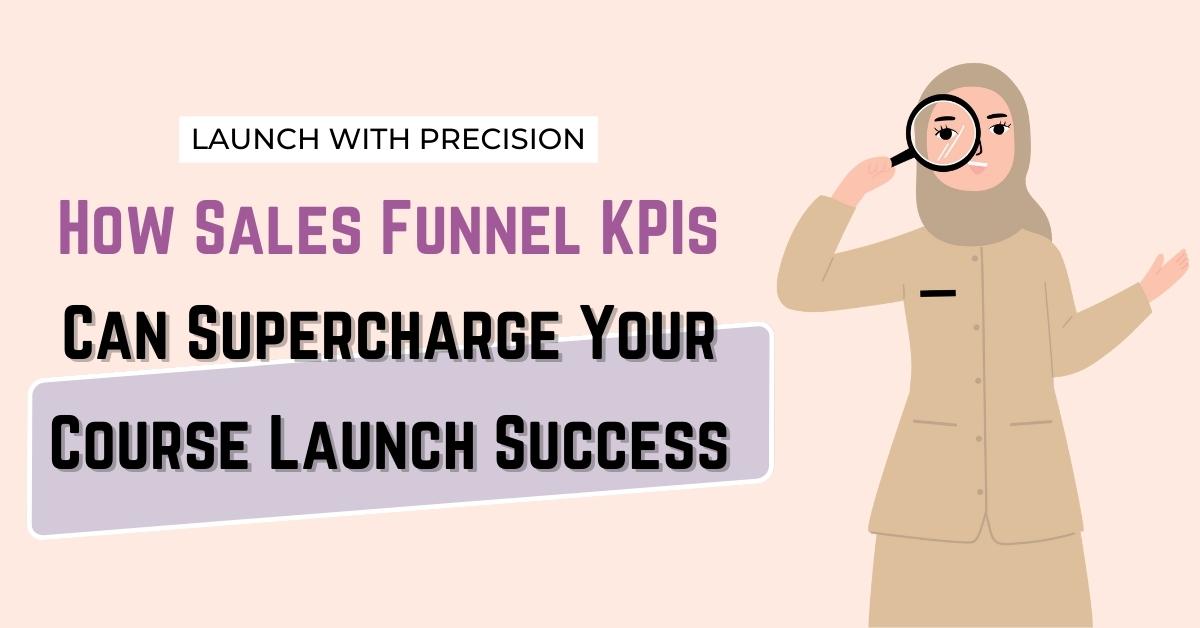
Are you ready to dive into the world of sales funnel metrics? Buckle up because we’re about to embark on a journey of data-driven success that will skyrocket your course launch to new heights!
You’re at the doorstep of launching your amazing online course, but there’s a crucial step you can’t afford to miss: measuring your funnel’s success. Fear not, because Nusrat (that’s me!), your go-to Certified Master Marketer, is here to guide you through the maze of metrics and unveil the secret sauce to a smashing course launch!
Picture this: You’ve poured your heart and soul into crafting your course, designing eye-catching visuals, and perfecting your sales funnel. But how do you know if all your efforts are paying off? That’s where sales funnel KPIs (Key Performance Indicators) swoop in to save the day! 🦸♀️ These powerful metrics are like a treasure map that reveals the hidden gems of your sales process, from the first click to the final sale.
Imagine having the power to tweak and optimize your funnel in real time, leading to more sign-ups, conversions, and, ultimately, course sales. It’s time to roll up your sleeves and dive into the juicy details of these essential metrics.
Unveiling Sales Funnel KPIs That You Must Track
Exploring the performance of your sales pipeline is crucial for your launch success. These KPI metrics are your compass, guiding you through the entire customer journey in your business of acquisition, engagement, conversion, and retention. Let’s get into unveiling the four dynamic categories that house the key indicators, painting a clear picture of your sales funnel performance.
#1 Acquisition Metrics: Fueling Your Funnel Engine
Now, let’s talk about the magic behind attracting those potential customers to your digital doorstep. Acquisition metrics are like the trail of breadcrumbs leading your audience right to your website and sales funnel. These metrics are the Sherlock Holmes of the business world, uncovering just how effective your efforts are at luring in those curious minds.
So, what’s in store? Well, let’s explore some of the most exciting acquisition metrics that deserve a special spot in your sales funnel analytics tracking toolkit:
• Sales Page Traffic:
This is your funnel’s lifeblood! It’s the number of visitors coming to your sales page and where they’re coming from. Remember, more traffic doesn’t always mean success; it’s about attracting the right audience. You want the right people engaging with your content.
👉 How to track: Think of this as tracking footprints in the digital world. Use tools like Google Analytics to monitor the number of visitors and their origin.
👉 Action Step: If you’re not getting enough traffic, it may be time to pump up your marketing strategy to attract the right eye.
• Cost Per Acquisition (CPA):
How much are you investing to win over a new customer? CPA reveals the monetary cost (money spent on marketing and advertising) of acquiring each new customer. Keeping this metric in check helps you determine if you’re getting the most value from your marketing efforts.
👉 How To Calculate: Imagine this as balancing your marketing checkbook. Calculate your marketing expenses, then divide them by the number of brand-new customers you’ve gained.
👉 Action Step: Numbers matter, and so does efficiency. If your CPA is giving you sticker shock, it might be time to fine-tune your marketing strategies.
• Conversion Rate:
This gem measures the percentage of visitors who take a desired action. Whether it’s signing up for a webinar or making a purchase, a good conversion rate indicates effective engagement. Tracking this KPI helps you fine-tune your funnel’s persuasiveness.
👉 How to calculate: Imagine it’s the recipe for a conversion cake. Divide the number of successful conversions by the total number of visitors, and then multiply it by 100.
👉 Action Step: Content and design are your secret sauce. Enhance their appeal to boost that CTR and watch your audience engage like never before.
• Click-Through Rate (CTR):
How compelling is your copy and design? CTR measures the percentage of visitors who click on a link or call to action. It’s a litmus test for the effectiveness of your content in persuading visitors to take action.
👉 How to calculate: It’s like measuring how well your content’s magnetic pull works. To calculate your CTR, divide the number of clicks by the number of website visitors and multiply by 100.
👉 Action Step: Enhance your copy and design to boost CTR and engagement.
#2 Engagement Metrics: Crafting An Immersive Experience
You’ve lured them in, but now it’s time to engage them. Think of engagement metrics as your backstage pass to the captivating dance between your visitors and your sales funnel. These metrics are like the applause meter at a rock concert, measuring how your audience grooves to your rhythm.
So, let’s dive into the metrics that keep the dance floor buzzing. Here are some of the most intriguing engagement metrics that you’ll definitely want to have in your spotlight:
• Average Time On Page:
This KPI measures how long visitors stay engaged with your content. Longer times indicate strong interest, while shorter times might hint at content that needs a little boost. By enhancing your content and design, you can keep your audience captivated for longer periods.
👉 How to calculate: Picture this as a clock ticking on engagement. Sum up the time visitors spend on a page, then divide it by the number of visitors.
👉 Action Step: To increase the average amount of time on the page, make sure your copy is interesting and your design is visually appealing.
• Bounce Rate:
Ever been ghosted? Your website doesn’t want that either. The Bounce Rate metric gauges the percentage of visitors who depart after viewing just one page. A lower bounce rate suggests that your funnel is successfully guiding visitors through multiple pages, making it a more engaging experience. Whereas a high bounce rate indicates that visitors are not finding what they’re looking for or that your website is not engaging enough.
👉 How to calculate: Imagine it as your website’s first impression score. Divide the number of single-page visits by the total visits and multiply by 100.
👉 Action Step: Aim for a lower bounce rate by creating irresistible content and guiding visitors throught the funnel by following the sales funnel best practices.
• Pages Per Session:
This metric is like a gauge of interest. It measures the average number of pages viewed during a single session. More pages per session mean deeper engagement and a higher level of interest in your content.
👉 How to calculate: Think of it as a measure of curiosity. Divide the total number of pages viewed by the number of sessions.
👉 Action Step: Curiosity might have killed the cat, but it fuels engagement. Create captivating content to keep them clicking and exploring.
#3 Conversion Metrics: Turning Visitors Into Raving Fans
Conversion metrics are like the heartbeats of your sales funnel – they pulse with the excitement of turning curious onlookers into devoted customers. Think of them as the applause after a mind-blowing performance; they measure the impact your funnel has on captivating your audience’s attention and guiding them to take action.
Now, let’s dive into the metrics that unveil the magic behind the curtain. Here are some of the most captivating conversion metrics that you’ll want to spotlight:
• Sales Conversion Rate:
Ah, conversions—the heart and soul of your funnel. The Sales Conversion Rate is like the turbo boost that gives your funnel that extra kick measuring the percentage of visitors who take the desired action, like enrolling in your course. It’s like turning curious visitors into your biggest fans!
👉 How to calculate: Imagine it as turning curious minds into loyal followers. Divide the number of successful conversions by the total number of visitors.
👉 Action Step: Keep track of your sales funnel conversion rates over time and make changes to improve it if necessary.
• Customer Acquisition Cost:
Remember, it’s not just about getting them in but keeping them in. Customer Acquisition Cost calculates the investment for each new customer. Decreasing this cost while increasing your customer base equals sweet success! Your customer acquisition cost is like the oil that keeps your funnel engine running smoothly! It’s the amount of money you spend to acquire each new customer.
👉 How to calculate: Think of this as your customer investment. Divide your marketing costs by the number of new customers acquired.
👉 Action Step: Smart spending is the name of the game. Keep your acquisition costs in check while expanding your customer base for a winning equation.
• Cart Abandonment Rate:
Ever felt like someone left the dance floor just before the party got started? The cart abandonment rate measures the percentage of visitors who add items to their cart but don’t complete the purchase. Lowering this rate leads to more party attendees in your sales party. This metric unveils the gap between interest and completion, offering insights into potential areas for improvement in your sales process.
👉 How to calculate: Imagine it’s the dance of almost buyers. Divide the abandoned carts by the initiated checkouts and multiply by 100.
👉 Action Step: The party’s not over until it’s over. Streamline that checkout process to keep those carts moving smoothly through to the end.
• Lead-To-Customer Rate:
This metric showcases the transformation of leads into paying customers. It’s like watching your audience go from curious observers to enthusiastic participants in your grand performance.
👉 How to calculate: Think of it as turning prospects into your fan club. Divide the number of acquired customers by the total number of leads generated and multiply by 100.
👉 Action Step: Engaging your audience is like conducting a symphony. Nurture those leads and turn them into devoted fans with a stellar lead-to-customer rate.
#4 Retention Metrics: Building A Loyal Following
Retention metrics are the loyalty badges of your business – they showcase the strength of your relationships with your cherished customers. Imagine them as the warm applause that follows an encore; they gauge how well your funnel keeps your audience coming back for more, creating a fanbase that’s here to stay.
Now, let’s peel back the curtain and explore the metrics that reveal your fanbase’s dedication. Here are some of the most cherished retention metrics that deserve a spotlight:
• Customer Lifetime Value (CLV):
Ever wished you could predict the future? Customer Lifetime Value (CLV) measures the total amount of money a customer is expected to spend on a business’s products or services over their lifetime. A high CLV indicates strong customer loyalty and engagement. This metric is important because it can help you make strategic decisions about your marketing and customer retention efforts.
👉 How to calculate: Think of it as foreseeing your business’s fortune. Multiply the average order value by the number of purchases a customer makes over their lifetime.
👉 Action Step: Loyalty is the goldmine of success. Boost your CLV by delivering exceptional value and fostering lasting relationships with your customers.
• Repeat Purchase Rate:
This metric evaluates the proportion of customers who return for additional purchases. A high repeat purchase rate is a sure sign that your customers are enjoying the experience you offer and finding value in your offerings.
👉 How to calculate: Imagine it’s the encore performance of your funnel. Divide the number of customers who make repeat purchases by the total number of customers and multiply by 100.
👉 Action Step: Keep the party going! Craft offerings that keep your customers coming back for more, turning them into devoted fans of your brand.
• Churn Rate:
Watch out for the Churn Rate, the percentage of customers who decide to part ways with your business over a specific period and bid adieu. A low churn rate signifies customer satisfaction and loyalty, while a high churn rate may indicate areas needing improvement.
👉 How to calculate: Think of it as saying goodbye to customers. Compute the churn rate by dividing the count of customers lost during a specific period by the total number of customers at the beginning of that period. Then, multiply the result by 100.
👉 Action Step: Retention is your ace in the hole. By minimizing your churn rate, you’re not only holding onto customers but also paving the way for sustainable growth.
How Can You Use Sales Funnel KPIs To Optimize The Funnel
Ready to take action? Setting Goals and Benchmarks is your first pit stop. It’s like plugging your destination into a GPS—knowing where you’re headed is key.
As you do the funnel analysis, keep an eagle eye on areas for improvement. Just like a car needs regular maintenance, your funnel requires tweaks to keep it running smoothly.
The best part? Your KPIs are your co-pilots, guiding you toward data-driven decisions. Want to know if your recent design tweak boosted engagement? Your KPIs have the answer!
Time for some tinkering! Implement changes based on your KPI insights. So, come on, be a skilled mechanic, get ready to fine-tune your funnel for peak performance.
In Conclusion: Your Funnel’s Roadmap to Success
So, there you have it—a whirlwind tour of the metrics that will make your course launch an out-of-this-world success! Remember, sales funnel KPIs are like the compass that guides you through the stormy seas of digital marketing. By tracking these metrics—Acquisition, Engagement, Conversion, and Retention—you’re equipped to steer towards your sales funnel optimization and victory.
As you set sail on your course launch adventure, armed with the insights from these KPIs, you’re not just launching a course; you’re crafting a transformative experience for your audience.
Burning Questions Addressed
1. What Are The Key Metrics To Track To Supercharge My Course Launch Success?
Great question! When it comes to propelling your course launch to new heights, Sales Funnel KPIs are your secret weapon. These metrics are like a treasure map that guides you through the intricate journey of acquisition, engagement, conversion, and retention.
By tracking the right key indicators, you’ll be armed with the data to tweak and optimize your funnel for maximum impact and course sales that soar.
2. What’s The Secret Behind Engagement Metrics? How Can I Make Visitors Fall In Love With My Funnel?
Engagement metrics hold the key to crafting an immersive experience that visitors can’t resist. Think of them as your backstage pass to a captivating dance between your audience and your sales pipeline.
By monitoring Average Time on Page, Bounce Rate, and Pages per Session, you can create content and design that captivates your audience longer, guides them deeper into your funnel, and keeps them grooving to your rhythm.
3. Turning Visitors Into Raving Fans Through Conversion Metrics – Can I Really Achieve That?
Absolutely! Conversion metrics are the heartbeats of your sales cycle, pulsing with the excitement of turning curious onlookers into devoted customers. These metrics measure the impact your funnel has on captivating your audience’s attention and guiding them to take action.
By optimizing your Sales Conversion Rate, Revenue Per Visitor, and Customer Acquisition Cost, you can turn casual visitors into those who can’t wait to hit that “Enroll” button.
4. Why Should I Aim For A Low Churn Rate? How Does It Affect My Customer Base?
Aiming for a low Churn Rate is like keeping the doors of your business open to a loyal crowd. Churn Rate measures the percentage of customers who bid adieu, and a low rate signifies that your customers are engaged and satisfied with your offerings.
Retaining your customer base is a cost-effective strategy compared to constantly acquiring new customers. By focusing on a low Churn Rate, you build a strong foundation for long-term success.
5. What’s The Real Impact Of Customer Lifetime Value (CLV) On My Business? Can It Predict Future Revenue?
Customer Lifetime Value (CLV) is your crystal ball, offering a glimpse into the future revenue each customer might bring. This metric allows you to strategically plan your marketing efforts and customer retention strategies.
A higher CLV means that your customers are not only making repeat purchases but also becoming your advocates. It’s a powerful indicator of your business’s long-term health and potential for sustainable growth.
So, yes, CLV can indeed predict future revenue and guide your business decisions.
While all these metrics offer valuable insights, the priority of each may vary based on your specific sales funnel goals and strategy. It’s important to focus on the KPIs that align most closely with optimizing your funnel’s performance and driving course sales. Keep the most impactful ones in your spotlight and adjust your tracking strategy as your funnel evolves.
And hey, if you ever need a fellow captain on this exhilarating journey or someone to fine-tune your funnel’s engine, don’t hesitate to reach out. Your success is my passion, and together, we’ll navigate the course launch seas with confidence and flair!
Ready to get started? Let’s plan for success! Schedule a discovery call with me at nusratgeek.com/discovery-call. I’m excited to dive into your dreams and guide your course launch to greatness. See you on the discovery call!
So, gear up! Let’s make this launch the talk of the town and set sail toward a horizon of success!
Here’s to data-driven success! 🚀




